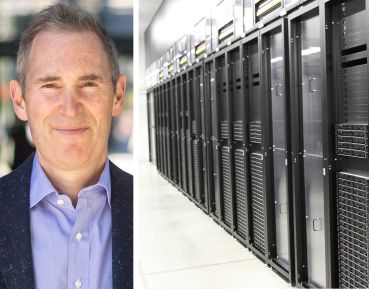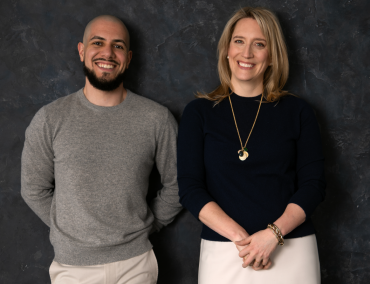JLL CTO Yao Morin Talks Data and Technology Strategy for CRE
And how Snoopy led her from China to getting a Ph.D. in electrical engineering in Minnesota
By Philip Russo June 13, 2023 9:00 am
reprints
Yao Morin is not merely JLL’s chief technology officer. She convinced the global brokerage services firm to create the position — and then campaigned successfully to win the job.
Since assuming the CTO mantle in May 2023, Morin has set about to direct the company’s technology strategy, overseeing teams of data engineers and analysts within its proptech division, JLL Technologies.
Building on her organizational data management experience with companies such as eBay, Intuit and StubHub, Morin joined JLL (JLL) in April 2020, rising swiftly in the firm despite never working in the real estate industry.
Born in Canton, China, Morin arrived in the U.S. to pursue first a master’s and then a doctorate in electrical engineering from the University of Minnesota.
Speaking from her home in San Francisco, Morin talked to Commercial Observer last week about the difference between the duties of a chief data officer and a chief technology officer, the importance of aligning tech with a brokerage services’ business lines, and how even the most talented and ambitious professionals need mentoring.
The interview has been edited for length and clarity.
Commercial Observer: You came from outside the real estate industry, but moved up quickly in data science before and since joining JLL. To what do you attribute your fast rise?
Yao Morin: That’s a really good question. From a leadership perspective, I believe that I have had a lot of good mentors and people who are actually willing to give me a lot of opportunities for which I may not seem to have the qualifications. For example, the reason for my promotion from chief data officer to chief technology officer is that when I approached my CEOs [Mihir Shah and Yishai Lerner, co-CEOs at JLL Technologies] about the idea of creating the CTO role for JLL and what I could bring to the table, they didn’t say no to me, but worked with me to craft this role. I really thank them and all my mentors who have believed in me for my fast rise.
One of the things that I’m willing to do is lead as a technologist. The technology leader should stay on top of what is the right technology to adopt. Second is to build a good team and give people growth opportunities, which delivers good value for the business and eventually becomes something that leadership can see.
What is the difference in your duties as CTO compared to when you were chief data officer?
First of all, if you ask 100 chief data officers, they will give you 100 different answers to what they do. In my opinion, and I have been doing data more than a decade, the concept has evolved. But I firmly believe that it actually evolved into a more comprehensive role than when it first started.
Ten or 15 years ago a chief data officer was mainly a data strategist who very narrowly focused on either the high-level data strategy for the company to adopt, or a data scientist who was more like a technologist consulting with the company to understand the use of data science and technologies. Now it has evolved into the chief data officer being this comprehensive role that is responsible for end-to-end data strategy crafting for the company as well as the technology implementation for that strategy, including the data platform, data engineering and analytics. It’s more about how we leverage the data for the enterprise.
And then the governance piece, which JLL is very much focused on, is making sure that we protect our clients’ data and respect their privacy and security. So that is also part of the chief data officer’s job. I think CTO is everything on top of the chief data officer and more. In my opinion, the CTO’s job also includes building software and applications, architecture and enterprise systems that are for internal software usage as well as building technology revenues for JLL.
To whom do you report as chief technology officer?
I report to the co-CEOs of JLL Technologies, Mihir Shah and Yishai Lerner.
It is difficult to integrate technology throughout a large global organization. How does your work in technology integrate with the overall brokerage services of the JLL?
Adoption can be hard at times. So the way that we work on this is we actually align very closely with our five business lines: leasing, capital markets, work dynamics — which is mostly facility management, project management, etc. — and then LaSalle, which is our investment management services. Also JLL Technologies, as we have our own revenue as well. We have technology groups for each, so they work very closely with the business line, really hearing their problems and then building software that is for them.
If it’s not something that they can use or solve their problems, then you will have an adoption problem. We really listen to them and design together with them. That’s how we make sure that we have good adoption. There are always more problems than we can solve, but we have people to solve them. We also prioritize with them as well.
What does your day-to-day work look like? What are your challenges short and long term?
There are a lot of day-to-day operational processes. As a more than 230-year-old company, JLL has a lot of technologies. You can’t run such a big business without software technologies and data. However, with the new JLL Technologies, we are actually trying to change how JLL sees technology. Having JLL Technologies is a key differentiator between us and our competitors. We also see technology as a revenue stream. To do that we need to build a technology group differently. We need to have the right software development life cycle, the right talent, structure, and talent management process to actually manage those talents. That’s what I do, focusing on the short term.
In the long term, I care about how I position our technology stack and our tech talent for the next 10 years. Data is still a key focus for everyone. However, that evolved into how to use data to leverage generative AI, this new technology breakthrough. How can we leverage that for our next generation of software products? How can JLL leverage this new technology to win?
Without going too far down the rabbit hole of generative AI, how do you view it at the moment? Is it as close as some say?
I don’t see it as far away at all. In fact, a lot of my teams are already doing a lot of proofs of concept in solving some of the problems that we couldn’t solve before. My view is generative AI is a revolutionary technology similar to mobile technology. It will be a must-have just like a mobile app is a must-have. That’s why it’s crucial for JLL to understand the technology and not to be afraid of it. And then to start using it for solving the problems that we couldn’t solve before.
Let’s step back a little to talk about your background. Where are you from originally, and how did you get to the University of Minnesota where you received your master’s and Ph.D.?
I’m originally from Canton, China. I always loved data and operations research. Data science before it was data science was operations research, and a lot of it was about leveraging data to optimize industrial processes, engineering processes, and to design algorithms. So I went to university, and the joke is I really liked Snoopy when I was growing up. I don’t know if you knew that the author of “Peanuts” was originally from Minnesota. The Mall of America has Camp Snoopy, and when you live in St. Paul you see these Peanuts characters all over the city. So that’s what I usually tell people without going too deep.
But the real reason was that the professor who was my adviser at Minnesota was one of the key people in operations research, and then advised the authors of a lot of the books that we study in data science now.
What happened after you received your Ph.D.?
I graduated in 2008 with my Ph.D., and then, unless you live under a rock, you know what happened in 2008. It was the financial crisis. So it was a little bit difficult to find a perfect job. I was very lucky to actually get into a law firm as a science adviser working on patent lawsuits, interpreting infringement case patterns, and understanding the technology behind it to advise the attorneys. I quickly found that I like doing my own invention rather than reading other people’s inventions.
After a couple of years, I decided now’s a good time to look for other opportunities, and I started to work on a lot of fun projects funded by the U.S. Department of Defense to leverage data and operations research data science.
Later, I wanted to go into more of a commercial space and I started working at Intuit. That’s where I learned a lot of how software development works. Then I went to eBay. I felt like I experienced a good variety of different industries, practices and company sizes. Actually one of the startups I worked at before Intuit, the CEO was Dan Goldin. He was the head of NASA during the Clinton administration. So I learned a lot from him in terms of how government organization works. It’s been a very interesting journey for me.
How did you come to the commercial real estate services world?
I was looking for my next job and I got some more traditional technology opportunities with big tech companies. I was almost about to sign and then JLL reached out to me. I had a conversation with Mihir and Yishai. They described proptech to me as really being the next big thing. When I was at Intuit, fintech was the hottest thing. You got all this investment from VCs and big companies, everyone trying to invest in fintech. And then a lot of cool technology got invented that changed how everyone can manage their finances and become very transparent and have a lot more options on different financial products. I really saw and felt that revolution because I was part of it when I was at Intuit.
They sold me on proptech as the next fintech. If you look at the VC investment, proptech has already surpassed fintech as the biggest investment category. I think it’s the right place to be, and that’s why that’s why I came here.
In today’s working remotely world, where do you usually work?
I live in San Francisco. I usually go into the office at least three times a week. But I love working in the office. The thing is that brokers are office people too. You want to be close to your customers. You want to be aligned with them. You want to understand their problems. What better way to do it than being in the office?
The increasingly competitive demand for technological talent is something we hear about all the time. Given that demand, is there any differentiation anymore between women and men technologists, or is it just that the need is so high that nobody cares?
Oh, I definitely care and I think that other people care. DEI [diversity, equity and inclusion] is very close to my heart. If you go to college nowadays, the percentage of women and men is not that different, unless you go into mechanical engineering. But in computer science, math, statistics, data science — there are a lot of women. So we don’t have an excuse not to attract women talent.
Sometimes it’s hard if you don’t have a role model in the field, to understand where you can get to. As a woman technologist, as a woman leader, I do have hiring power. It’s very important for us to have that perspective in our hiring and promotion process, as well as how we create opportunities for mentorship, coaching, and being intentional in getting women and other underrepresented minorities into our pipeline. That is very important to me.
Did you find resistance to you as a woman as you ascended in your technology career? No, I actually didn’t find a lot of pushback, personally. I learned that if I want to get to something, if I have ambition, then I need to talk to people about it and get people to help me to get there.
Looking forward, how do you view incumbent real estate’s development, adoption and integration of proptech?
I think it’s definitely speeding up. As long as there are good products and the products are solving the right problems, I can see adoptions going up. In terms of entry barriers for technology, it is a little higher in real estate because real estate is not just one thing — it’s many, many different services and products. You really need to understand the workflow of technology for the real estate practitioner, what kind of real problems they have, especially in commercial real estate.
That creates some challenges in adopting great products. However, once you crack that nut, once you understand the right problem to solve, how workflow works in commercial real estate, I think that we get quite good products and good adoptions. It’s a really challenging area to work in, but it is also very rewarding once you figure that out.
Philip Russo can be reached at prusso@commercialobserver.com.


